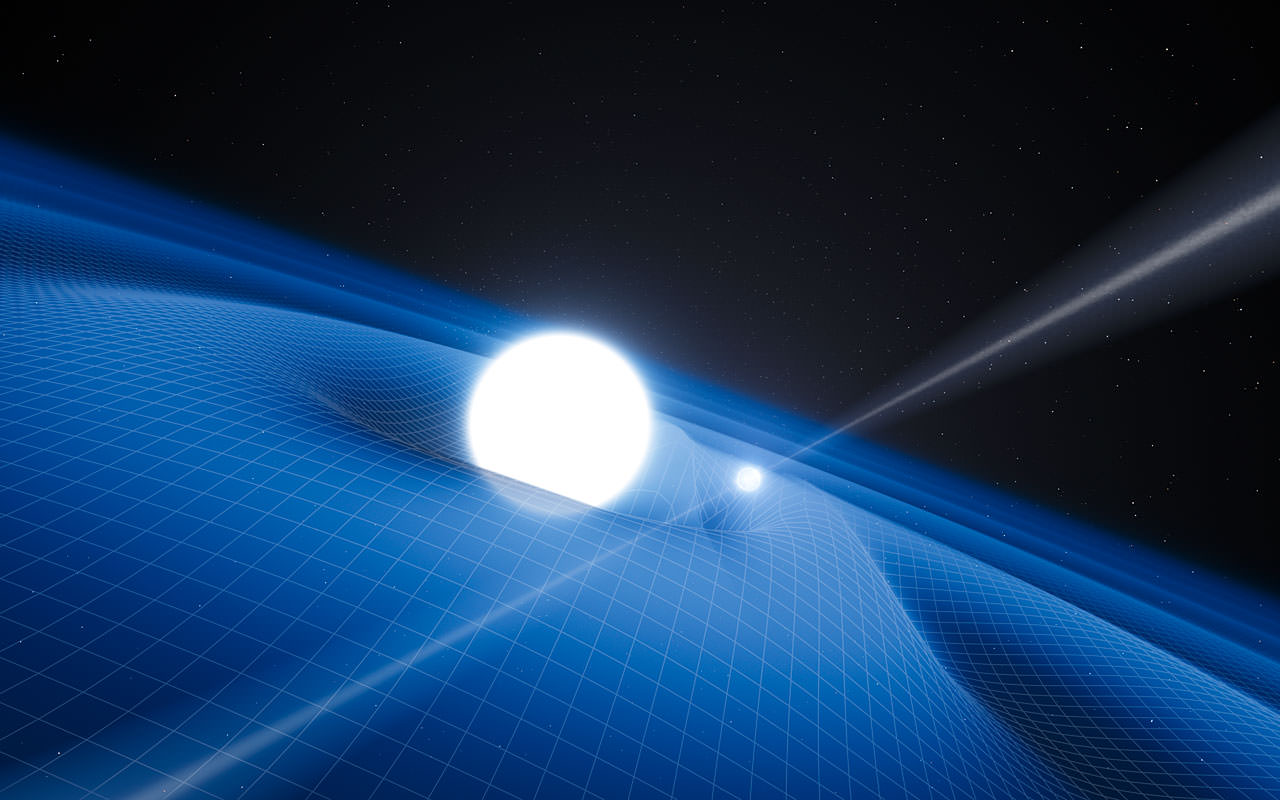A unique and exotic laboratory about 6,800 light-years from Earth is helping Earth-based astronomers test Albert Einstein’s theory of general relativity in ways not possible until now. And the observations exactly match predictions from general relativity, say scientists in a paper to be published in the April 26 issue of the journal Science.
Using ESO’s Very Large Telescope along with other radio telescopes, John Antoniadis, a PhD student at the Max Planck Institute for radio Astronomy (MPIfR) in Bonn and lead author of the paper, says the bizarre pair of stars makes for an excellent test case for physics.
“I was observing the system with ESO’s Very Large Telescope, looking for changes in the light emitted from the white dwarf caused by its motion around the pulsar,” says Antoniadis. “A quick on-the-spot analysis made me realize that the pulsar was quite a heavyweight. It is twice the mass of the Sun, making it the most massive neutron star that we know of and also an excellent laboratory for fundamental physics.”
The strange pair consists of a tiny and unusually heavy neutron star that spins 25 times per second. The pulsar, named PSR J0348+0432 is the remains of a supernova explosion. Twice as heavy as our Sun, the pulsar would fit within the confines of the Denver metropolitan area; it’s just 20 kilometers across or about 12 miles. The gravity on this strange star is more than 300 billion times stronger than on Earth. At its center, where the intense gravity squeezes matter even more tightly together, a sugar-cubed-sized block of star stuff would weight more than one billion tons. Only three other pulsars outside globular clusters spin faster and have shorter periods.

As a consequence, radio astronomers Ryan Lynch and colleagues who discovered the pulsar in 2011, realized the pair would enable scientists to test theories of gravity that were not possible before. Einstein’s general theory of relativity describes gravity as a curvature in spacetime. Like a bowling ball nestled in a stretched bedsheet, spacetime bends and warps in the presence of mass and energy. The theory, published in 1916, has withstood all tests so far as the simplest explanation for observed astronomical phenomena. Other theories of gravity make different predictions but these differences would reveal themselves only in extremely strong gravitational fields not found within our solar system. J0348+0432 offered the opportunity to study Einstein’s theory in detail.
This video shows an artist’s impression of the exotic double object known as PSR J0348+0432. This system is radiating gravitational radiation, or ripples, in spacetime. Although these waves cannot be yet detected directly by astronomers on Earth they can be detected indirectly by measuring the change in the orbit of the system as it loses energy. Credit: ESO/L.Calçada
Antoniadis’ team combined observations of the white dwarf from the European Southern Observatory’s Very Large Telescope with the precise timing of the pulsar from other radio telescopes, including the Green Bank Telescope in West Virginia, Effelsberg 100 meter radio telescope in Germany, and the Arecibo Observatory in Puerto Rico. Astronomers predict such close pulsar binaries radiate gravity waves and lose minute amounts of energy over time causing the orbital period of the white dwarf companion to change slightly. The astronomers found that predictions for this change closely matched those of general relativity while competing theories were different.
“Our radio observations were so precise that we have already been able to measure a change in the orbital period of 8 millionths of a second per year, exactly what Einstein’s theory predicts,” states Paulo Freire, another team member, in the press release.
Sources:
ESO: Einstein Was Right – So Far
Astrophysical Journal: The Green Bank Telescope 350 MHz Drift-scan Survey II: Data Analysis and the Timing of 10 New Pulsars, Including a Relativistic Binary
Aspen Center for Physics Physical Application of Millisecond Pulsars meeting January 2013: The Compact Relativistic Binary PSR J0348+0432

